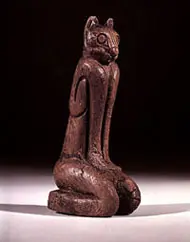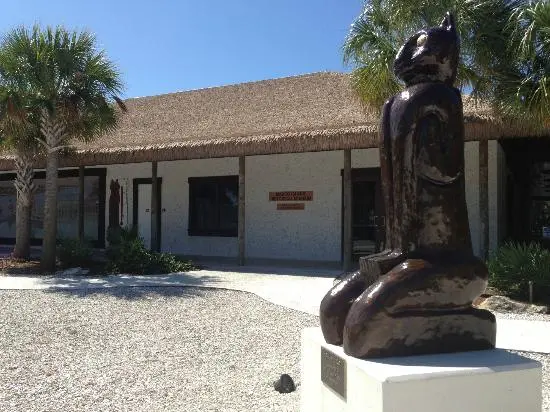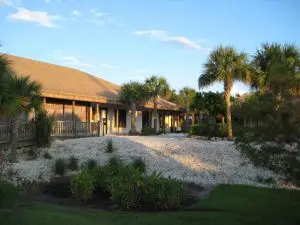The Key Marco Cat, a part feline, part human wood carving, is one of the most intriguing Native American artifacts discovered in Florida.
In 1896, archaeologist Frank Hamilton Cushing led an excavation on Marco Island that uncovered the six-inch-tall Key Marco Cat along with thousands of other Calusa Indian artifacts. The excavation was one of the first formal, organized archaeological expeditions in the state.
In addition to the Key Marco Cat, Cushing’s team excavated vibrantly colored ceremonial masks and other carved objects, identifying the Calusa as one of the most artistic tribes to inhabit Florida prior to European contact.
“Because they lived in this very rich environment with the estuary system, the fish was plentiful, the shellfish was plentiful, so they didn’t spend any time worrying about food,” says Craig Woodward, director of the Marco Island Historical Museum.
“They were not an agricultural tribe, they were able to get food (from the water), and had plenty of time to devote to artistic things, which is fascinating to us today.”
The Calusa artifacts discovered on Marco Island date from 300 AD to 1500 AD, prior to European contact in Florida.
Spanish conquistador Juan Ponce de León landed on the east coast of Florida and gave our state its name in 1513. When Ponce returned to southwest Florida in 1521, he was attacked by the Calusa and died from the wounds they inflicted.
Within about two centuries the Calusa were extinct, either having died from diseases brought by the Europeans, been captured as slaves, or been absorbed into the Seminole Tribe who arrived in Florida in the 1700s.
Created in 2010, the Marco Island Historical Museum is dedicated to remembering the Calusa. The museum campus was designed to have visitors walk through an interpretation of a Calusa village before they enter the museum.
“When you drive down the road, you look over and see a shell mound that’s been built, and we built an estuary system around the shell mound which lowers that area,” says Woodward. “We put cypress trees and native plants down there. Then on the shell mound you have a lagoon area which has a waterfall at one end and a fish weir at the other end, and a bridge crossing it to a chickee hut.”
The three large buildings of the museum complex are also designed to resemble a Calusa village. Taking a cue from Disney World, the museum designers used an extruded plastic product to create a thatched roof appearance, rather than actual palm fronds.
Woodward says that before visitors to the museum enter the main buildings, they walk from the present into the past.
“To get to the shell mound you have to cross the bridge from the parking lot, so you leave the modern world from the parking lot to the shell mound and enter a whole new world. We wanted to bring the inside out. So, unlike a regular museum where it’s all inside, a lot of our museum is outside, too.”
As visitors make their way through the village to enter the museum, they encounter a human size bronze sculpture of the Key Marco Cat, one of the most enduring symbols of the Calusa tribe. Inside the museum is a replica of original six-inch wooden figure.
“The Key Marco Cat is at the Smithsonian (in Washington, D.C.). It has come to Collier County twice,” says Woodward. “It was in Naples on display as a visiting item, and then it came to Marco Island. When it was at Marco, 18,000 people came to see it, so there’s a huge amount of interest in having it here.”
In an effort to have the Key Marco Cat permanently returned to the place it was found, the Marco Island Historical Museum contains a climate controlled cement structure with thick glass windows, specifically designed to house the unique artifact.
“The main part of the museum is dedicated to the Calusa, and hopefully, the items that we can get from that (Cushing) expedition,” says Woodward.
Some of the Calusa artifacts uncovered on Marco Island in 1896 are currently displayed at the British Museum in London, the University Museum of Philadelphia, and the Florida Museum of Natural History in Gainesville.
Dr. Ben Brotemarkle is executive director of the Florida Historical Society and host of the radio program “Florida Frontiers,” broadcast locally on 90.7 WMFE Thursday evenings at 6:30 and Sunday afternoons at 4:00, and on 89.5 WFIT Sunday mornings at 7:00. The show can be heard online at myfloridahistory.org.


